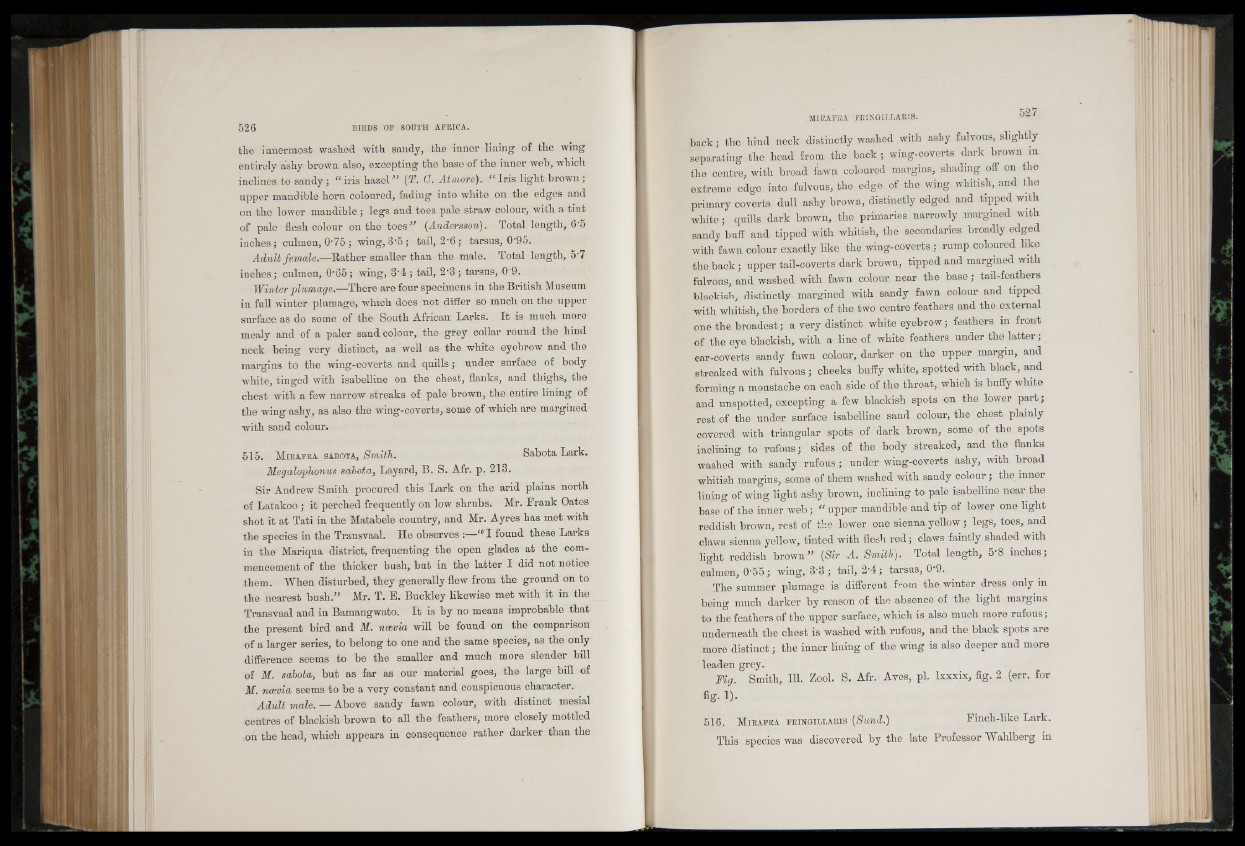
the innermost washed with sandy, the inner lining of the wing
entirely ashy brown also, excepting the base of the inner web, which
inclines to sandy ; “ iris hazel ” [T. G. Atmore). “ Iris light brown ;
upper mandible horn coloured, fading into white on the edges and
on the lower mandible ; legs and toes pale straw colour, with a tint
of pale flesh colour on the toes” (Andersson). Total length, 6’5
inches ; culmen, 075; wing, 3‘5; tail, 2• 6 ; tarsus, 0‘95.
Adult female.—Rather smaller than the male. Total length, 5-7
inches; culmen, 0*65; wing, 3‘4 ; tail, 2‘3 ; tarsus, 0 9.
Winter 'plumage.—There are four specimens in the British Museum
in full winter plumage, which does not differ so much on the upper
surface as do some of the South African Larks. It is much more
mealy and of a paler sand colour, the grey collar round the hind
neck being very distinct, as well as the white eyebrow and the
margins to the wing-coverts and quills ; under surface of body
white, tinged with isabelline on the chest, flanks, and thighs, thè
chest with a few narrow streaks of pale brown, the entire lining of
the wing ashy, as also the wing-coverts, some of which are margined
with sand colour.
515. M ira fba sabota, Smith. Sabota Lark.
Megalophonus sabota, Layard, B. S. Afr. p. 213.
Sir Andrew Smith procured this Lark on the arid plains north
of Latakoo ; it perched frequently on low shrubs. Mr. Frank Oates
shot it at Tati in the Matabele country, and Mr. Ayres has met with
the species in the Transvaal. He observes :—ct I found these Larks
in the Mariqua district, frequenting the open glades at the commencement
of the thicker bush, but in the latter I did not notice
them. When disturbed, they generally flew from the ground on to
the nearest bush.” Mr. T. E. Buckley likewise met with it in the
Transvaal and in Bamangwato. It is by no means improbable that
the present bird and M. ncevia will be found on the comparison
of a larger series, to belong to one and the same species, as the only
difference seems to be the smaller and much more slender bill
of M. sabota, but as far as our material goes, the large bill of
M. ncevia seems to be a very constant and conspicuous character.
Adult male. — Above sandy fawn colour, with distinct mesial
centres of blackish brown to all the feathers, more closely mottled
on the head, which appears in consequence rather darker than the
back; the hind neck distinctly washed with ashy fulvous, slightly
separating the head from the back ; wing-coverts dark brown in
the centre, with broad fawn coloured margins, shading off on the
extreme edge into-fulvous, the edge of the wing whitish, and the
primary coverts dull ashy brown, distinctly edged and tipped with
white; quills dark brown, the primaries narrowly margined with
sandy buff and tipped with whitish, the secondaries broadly edged
with fawn colour exactly like the wing-coverts ; rump coloured like
the back; upper tail-coverts dark brown, tipped and margined with
fulvous, and washed with fawn colour near the base; tail-feathers
blackish, distinctly margined with sandy fawn colour and tipped
with whitish, the borders of the two centre feathers and the external
one the broadest; a very distinct white eyebrow; feathers in front
of the eye blackish, with a line of white feathers under the latter;
ear-coverts sandy fawn colour, darker on the upper margin, and
streaked with fulvous; cheeks buffy white, spotted with black, and
forming a moustache on each side of the throat, which is buffy white
and unspotted, excepting a few blackish spots on the lower part;
rest of the under surface isabelline sand colour, the chest plainly
covered with triangular spots of dark brown, some of the spots
inclining to rufous; sides of the body streaked, and the flanks
washed with sandy rufous; under wing-coverts ashy, with broad
whitish margins, some of them washed with sandy colour; the inner
lining of wing light ashy brown, inclining to pale isabelline near the
base of the inner web; “ upper mandible and tip of lower one light
reddish brown, rest of the lower one sienna, yellow ; legs, toes, and
claws sienna yellow, tinted with flesh red; claws faintly shaded with
light reddish brown” {Sir A. Smith). Total length, 5-8 inches;
culmen, 0'55; wing, 8'3 ; tail, 2*4; tarsus, 09.
The summer plumage is different from the winter dress only in
being much darker by reason of the absence of the light margins
to the feathers of the upper surface, which is also much more rufous;
underneath the chest is washed with rufous, and the black spots are
more distinct; the inner lining of the wing is also deeper and more
leaden grey.
Fig. Smith, 111. Zool. S. Afr.- Aves, pi. lxxxix, fig. 2 (err. for
fig. 1).
516. M ir a fr a FRiHGtiLUARis (Sund.) Finch-like Lark.
This species was discovered by the late Professor Wahlberg in